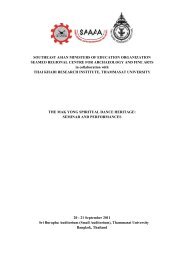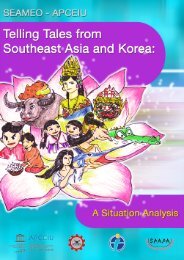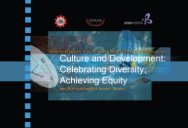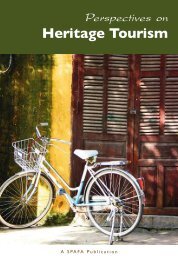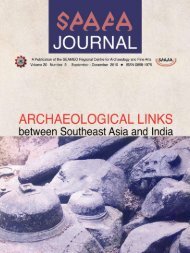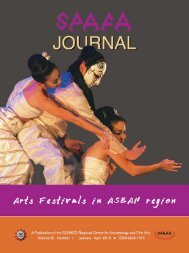Making Mangrove - Seameo-SPAFA
Making Mangrove - Seameo-SPAFA
Making Mangrove - Seameo-SPAFA
Create successful ePaper yourself
Turn your PDF publications into a flip-book with our unique Google optimized e-Paper software.
The Bangpakong <strong>Mangrove</strong>Eco-Museum ProjectPisit CharoenwongsaThe Eco-Museum of <strong>Mangrove</strong>At the Bovorn Witthayayon school, the mangrove isthe museum. This outdoor museum represents botha museum and a classroom without walls, and is opento all who come for recreation or to study the natureand culture of the mangrove. The area concerned iscomposed of water, earth, and organisms, which includeplants and animals cohabitating with human beings, anddepending on each other for sustenance.The museum was conceived at an alumni meeting,chaired by Professor Wichit Srisa-an, when <strong>SPAFA</strong> CentreDirector proposed a new type of museum to showcasethe mangrove existing in the school environs. The AlumniAssociation’s Museum Committee, chaired by ProfessorWichit Srisa-an, conceived and proposed the idea ofdeveloping the school area into a museum and centrefor educational and recreational purposes.The eco-museum can accommodate between forty andfifty visitors at a time. There are elevated walkways overthe water, leading to the view and study of various kindsof plants, marine life-forms, a collection of donated boats,all of which provide the visitor substantial information forunderstanding type, physiography, and function.A school and anoutdoor museumEnvironmentalresources arestudied in classesThere is also a pavilion to display temporary and specialexhibitions that highlight the relevance of the mangroveor museum to the community, and raises awareness whilstinstilling a sense of communal protection for it. Scientificinformation is presented on signboards, in an easilycomprehensible format; and focuses on various aspectsof the mangrove community: the ecology of mangrovesand its importance, effective practices in managementof its preservation and restoration, and the uses andfunctions of mangroves (emphasizing the long-termyield to be obtained for the improvement in mangrovedwellers’ quality of life, for instance).What impresses is the way the school teachers andstudents have utilised the knowledge on the mangroveas a content in many school subjects. In the teaching ofThai language, for example, the mangrove is used as aninspiration for the writing of poems and the compositionof songs and music.As such, the mangrove is integrated in many lessons andsubjects, an advanced concept in education that is notconfined only to the curriculum set up by the Ministryof Education of the national government.In teaching science, for instance, the species of plantsand animals are presented in a direct and straightforward16 <strong>Making</strong> <strong>Mangrove</strong> Eco-Museums<strong>Making</strong> <strong>Mangrove</strong> Eco-Museums 17



